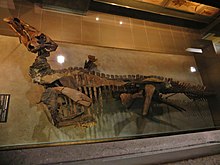 The Edmontosaurus mummy SMF R 4036 in the Naturmuseum Senckenberg, Frankfurt am Main, Germany, in top view | |
| Catalog no. | SMF R 4036 |
|---|---|
| Species | Edmontosaurus |
| Age | 69.5 million years |
| Place discovered | Wyoming, United States |
| Date discovered | 1910 |
| Discovered by | Sternberg family |
The Edmontosaurus mummy SMF R 4036 is an exceptionally well-preserved dinosaur fossil in the collection of the Naturmuseum Senckenberg (SM) in Frankfurt am Main, Germany. Found in 1910 in Wyoming, United States, it is ascribed to the species Edmontosaurus annectens (originally Trachodon), a member of the Hadrosauridae ("duckbilled dinosaur"). The fossil comprises a nearly complete skeleton that was found wrapped in impressions of its skin, a rare case of exceptional preservation for which the term "dinosaur mummy" has been used.[1] Notably, the horny beak is preserved with this specimen. Plant remains found within the thorax cavity had been interpreted as stomach contents, although later research questioned this identification. The mummy's hands are wrapped in skin impression, which was interpreted as evidence for interdigital webbing and an aquatic lifestyle in hadrosaurids; this hypothesis, although universally accepted once, is now widely refused. SMF R 4036 is one of the four best preserved hadrosaurid mummies, and was the second to be discovered.[2] The find was made by fossil hunter Charles Hazelius Sternberg and his sons, who sold their numerous finds to various museums in North America and Europe. Only two years earlier the Sternbergs had discovered the Edmontosaurus mummy AMNH 5060 in the same region, which is now on display at the American Museum of Natural History (AMNH) in New York City.
© MMXXIII Rich X Search. We shall prevail. All rights reserved. Rich X Search
